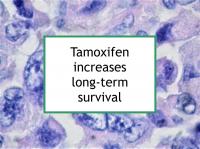Breast cancer can relapse many years after initial treatment, a phenomenon known as late recurrence. Early recurrence (within the first three years) is most likely to occur in women with aggressive subtypes such as triple negative (ER-/PR-/HER2-) and inflammatory breast cancer (IBC).
However, while hormone receptor positive (ER+/PR+) breast cancer tends to have more indolent characteristics, it is more likely to recur many years after diagnosis. Late relapse is thought to be caused by disseminated breast cancer cells that find their way to the bone marrow (which acts as a tumor cell reservoir) and then become dormant. Such tumor cells evaded eradication because they were not dividing at the time of treatment.
Late recurrence among women with ER+ disease has been linked to large tumor size (≥ 2 cm), positive lymph node status, and obesity. Now a new study has reported that tamoxifen treatment reduces or delays recurrence for up to 25 years after diagnosis, especially in women with large tumors.
Latest research finds tamoxifen reduces late recurrence
The study referenced above was designed to investigate whether prognostic markers known to predict short-term survival of ER+/HER2- disease also predict long-term survival. The study also examined whether conventional five-year tamoxifen treatment (not extended treatment that lasts up to 10 years) influences long-term outcomes. To conduct the study, the authors analyzed data from the Stockholm Tamoxifen (STO-3) trial which had been conducted from 1976 to 1990. STO-3 participants were lymph node-negative breast cancer patients who were randomly assigned to receive tamoxifen or no tamoxifen after breast cancer surgery.
Tumor size and tumor grade, but not progesterone receptor (PR) or Ki-67 (proliferation) status, were found to be associated with statistically significant differences in 25-year distant recurrence-free interval. For example, women with relatively small tumor size (T1a/b (<1 cm) or T1c (1-2 cm)) and tumor grade 1 had a markedly lower risk of recurrence than those with larger tumor size (T2 (2 to 5 cm)) and grade 3 tumors.
Women with larger tumor size (T1c or T2), lower tumor grade (Grade 1 or 2), and PR+ status were found to benefit disproportionately from tamoxifen treatment. Further analysis determined that tumor size was the most important characteristic that predicted survival. The authors conclude that tumor size, followed by grade, are significant markers of 25-year distant recurrence-free interval. In addition, a significant 25-year benefit from tamoxifen therapy was found in patients with larger tumor size, lower tumor grade and PR+ tumors.
Please see our article on impact of endocrine treatment on prognosis for more information.
